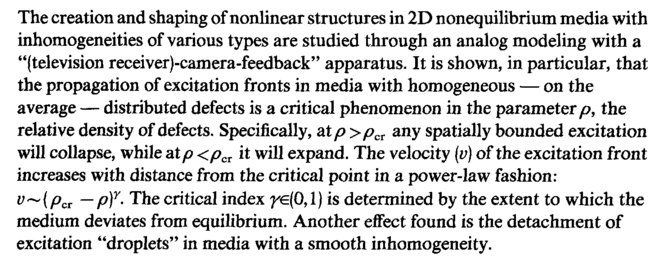|
|

| VOLUME 42 (1985) | ISSUE 3 |
PAGE 99
|
Critical phenomena in inhomogeneous excitable media; modeling on a "TV-ANALOG"
Golubev V. N., Rabinovich M. I., Talanov V. I., Shklover V. V., Yakhno V. G.
The creation and shaping of nonlinear structures in 2D nonequilibrium media with inhomogeneities of various types are studied through an analog modeling with a "(television receiver)-camera-feedback" apparatus. It is shown, in particular, that the propagation of excitation fronts in media with homogeneous — on the average — distributed defects is a critical phenomenon in the parameter p, the relative density of defects. Specifically, dXp >pct any spatially bounded excitation will collapse, while atp<pCT it will expand. The velocity (v) of the excitation front increases with distance from the critical point in a power-law fashion: v~(pCI —pYThe critical index ^€(0,1) is determined by the extent to which the medium deviates from equilibrium. Another effect found is the detachment of excitation "droplets" in media with a smooth inhomogeneity.
|
|


 Home
Home